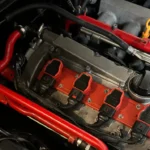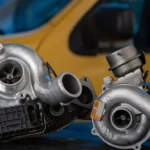
Turbocharger Care
Introduction
Turbochargers are incredible pieces of technology. They give us the ability to drastically increase power and torque numbers without the need to increase engine displacement. Turbos are engineered to function effectively in challenging environments for prolonged durations. Their internal parts move incredibly fast and are subjected to extremely high temperatures. Turbochargers are not invincible, they can prematurely fail if not properly maintained. With proper care and maintenance a turbocharger can last up to 200,000 miles. Listed below are several tips to help increase the lifespan of your turbo.
Cooldown Period After Use:
Turbos generate a significant amount of heat during operation, and turning off the engine immediately after intense driving halts the flow of fresh cool oil into the turbo. This prevents the turbo from being able to cool itself, causing the oil inside of the turbocharger to boil. This results in a build-up of carbon, which damages the turbocharger’s internal components and causes corrosion. To prevent this let the vehicle idle for a few minutes before shutting off the engine. Doing this allows engine oil to pass through and cool the turbo. Alternatively, mildly driving the last few miles to your destination has the same effect. One final note, water-cooled turbos do not have to worry about the cooldown period due to water’s cooling properties. The water pulls heat from the turbo, the heat turns the water into steam, the steam is displaced by “fresh” liquid water, effectively cooling the turbocharger. It is imperative you pay attention to the condition of your coolant system when using a water-cooled turbo. Never let your coolant get too low, and make sure you keep it clean by regularly changing it (every 5 years or 30,000 miles).
Oil:
Turbocharged vehicles require the use of high-quality synthetic oil. Make sure you are following your vehicle manufacturer’s guidelines when selecting oil for your vehicle. If your vehicle did not come equipped with a turbo from factory, choose a full-synthetic oil that is compatible with turbocharged vehicles. These oils are specifically formulated to withstand the high temperatures and pressures generated by the turbocharger. Pay close attention to your oil level. Do not let it get too low, the turbocharger requires an adequate amount of oil to operate. Keep an eye on the condition of your oil, the cleaner the better. Regularly change your oil every 3000 – 5000 miles. This ensures your turbo is always fed with fresh clean oil, helping extend the life of your turbocharger. Inspect your oil feed and return lines for leaks from time to time.
Warm-up Car Before Driving:
Engine oil is sensitive to temperature. When cold the oil is thick. Thick oil does not lubricate moving parts effectively. Driving immediately after a cold-start forces the engine to operate with cold thick oil. Doing this will wear down internal engine components at a faster rate due to poor lubrication, which increases contact and friction between moving parts. This can cause a lot damage to small engine components which require a significant amount of lubrication when operating. The turbocharger is a great example of said small components. It is recommended that you let the vehicle idle for a few minutes after starting the engine. This will raise the temperature of the oil, turning it from thick to thin, increasing its lubricating ability. Doing this ensures that your turbo is properly lubricated, which prevents premature wear. This only applies to cold-starts, if the car has been driven in the last 3 hours it is ok to reduce/eliminate the warm up time.
Air Filter/Compressor Inlet:
Daily driven road cars should use a filter to protect the turbocharger from rocks and debris. Rocks and debris from the road can damage the compressor wheel blades and potentially the entire rotating assembly. It is recommended that you use at least one of the following: OEM factory air box, cold air intake system, aftermarket cone filter, or turbo filters/guard. Vehicles designed for track and drag racing may not need filter upstream of the compressor inlet. This is entirely dependent on course/track environment and the type of race. It is very common for drag racers to opt-out of using a filter due to restriction and weight concerns. Rally drivers on the other hand, might choose to use an air intake system when racing on a dirt/gravel course.
Driving Style:
The way you drive has a huge effect on the longevity of your turbo. Consistently stabbing the gas pedal spikes boost pressure which can damage the internals of your turbo over time, decreasing longevity. Smooth acceleration, on the other hand, increases boost pressure at slower controlled rate. This limits spikes in force on the internals of the turbo. Driving easy for the first 10 minutes after a cold start helps in circulating oil throughout the turbocharger, which sufficiently lubricates the turbo, increasing its longevity. When driving, make sure you are in the appropriate gear for the speed you are driving. Do not “lug” the engine. Driving at low speeds while in a high gear will lug your engine. Driving up an incline in too high of a gear will also lug your engine. Lugging can place a lot of stress on the turbocharger, by causing it to over work. If your engine is lugging while driving, downshift to the appropriate gear. It is also recommended that you downshift when overtaking a vehicle instead of mashing the gas in your current gear, which puts extra wear and tear on the turbo’s. Gears were created to optimize efficiency throughout the rev range, use them to your advantage. Doing so can drastically slow the wear on your turbocharger.
Boost Leaks:
Boost leaks can increase wear on your turbocharger. Leaks in the charged-air path (downstream of the compressor) force the turbocharger to work harder to obtain the target boost pressure. This places more strain on the turbocharger, prematurely wearing its in internals. If you notice your vehicle consistently struggling to hit your boost target, check the charged-air path for leaks before turning up the boost.
Limit Back Pressure:
Excessive back pressure can damage your turbocharger over time. Too much back pressure puts additional strain on the turbine wheel (hot side). This causes the turbo to work harder in order to overcome the resistance created by back pressure in the exhaust path. Excessive back pressure can also trap heat in the exhaust path. This unwanted heat can hurt performance and overheat the turbocharger, damaging its components. The additional heat can cook the oil inside the turbocharger. As stated earlier cooked oil can’t adequately lubricate the internals of the turbo, leading to premature failure.
Conclusion
The health of your turbo directly affects its performance and how long it will last. A healthy turbo operates more efficiently, increasing the efficiency increases performance. Properly maintaining your turbo can help prevent turbo failure. Replacing a turbo can be very expensive and time consuming. Following these tips will significantly decrease the wear and tear your turbo experiences during its lifetime. Which will save you money and hard ache in the long run.



